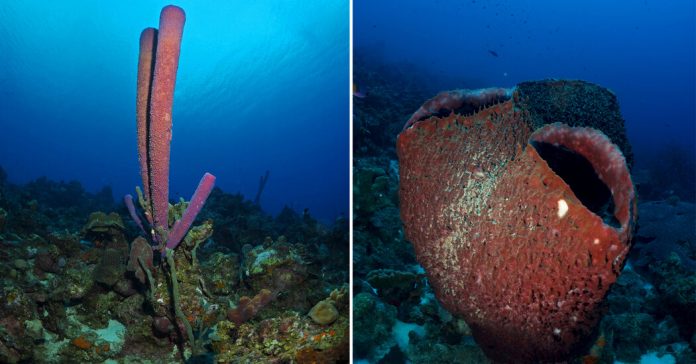Sneezing is way from a uniquely human conduct. Perhaps you’ve seen your canine or cat do it, or watched a YouTube video of a giraffe sneezing on an unsuspecting toddler on the zoo. In actual fact, sneezing doesn’t even require a nervous system, not to mention a nostril, and dates again to a few of the first multicellular animals: sponges.
The sponge has been round for a minimum of 600 million years. “It’s essentially the most profitable animal that I do know of, as a result of it’s so previous, and it’s in all places,” stated Jasper de Goeij, a marine ecologist on the College of Amsterdam. As filter feeders, sponges play a vital function of their aquatic ecosystems, drawing in water crammed with different natural matter, processing it and releasing it as waste on which organisms like snails, brittle stars and tube worms feed. “A sponge is mainly an animal that has a whole lot of little mouths and one, or a number of, bigger outflow openings,” stated Dr. de Goeij. These “little mouths” are referred to as ostia, and the openings the place water flows out are oscula.
For years, scientists have identified that sponges can regulate their water move with a many-minutes-long physique contraction — i.e., a “sneeze” — however now, Dr. de Goeij and colleagues have discovered that sponges seem to sneeze as a type of self-cleaning, releasing waste particles in mucus by their ostia. The work was printed in Present Biology on Wednesday.
The researchers got here throughout sponges sneezing snot whereas engaged on a challenge investigating the function performed by sponges in shifting vitamins by a reef ecosystem. The work required Niklas Kornder, one other marine ecologist at Amsterdam, to spend so much of time with sponges. “I might spend complete days simply wanting on the floor of them; it was fairly boring,” he recalled. (Mr. Kornder was scuba diving within the Caribbean on the time.)
Thankfully, issues obtained extra fascinating when he began seeing opaque stringy materials coming from the sponges. “Then I’d come again to it later, and the stringy issues can be gone,” he stated.
To determine what these “stringy issues” might be, the researchers recorded time-lapse footage of sponges, particularly the Caribbean tube sponge Aplysina archeri. Within the lab, they have been capable of establish the threads as streams of mucus carrying waste. They’d come out of the sponge’s ostia, transfer throughout the organism’s floor and mixture into clumps that might be launched with a sneeze, after which shortly devoured up by different ocean critters.
When first reviewing the time-lapse footage, Yuki Esser — a bioinformatics graduate pupil at Amsterdam on the time and a examine co-author — was dissatisfied, considering that the motion she was seeing (i.e., the sneeze) was only a digital camera focusing error. “I believed there should be a drop of water or one thing on the digital camera lens inflicting this,” she stated. However she quickly realized it wasn’t a mistake. And as soon as Ms. Esser and her colleagues discovered that they had captured almost an identical time-lapse video of A. archeri off the coast of Curaçao, recording footage “turned form of a sport,” she stated. “Like, ‘Perhaps we caught one other sneeze on digital camera!’”
The researchers consider sneezing out waste-laden mucus is a widespread tactic amongst sponges all around the world. And the examine stirs up extra questions, stated Sally Leys, an evolutionary biologist on the College of Alberta and a co-author of the examine.
“The mucus,” she stated. “Is it much like different animals’ mucus? And what cells are making it?” She additionally desires to know what triggers the sneeze. “When our nostril is dripping, we deliver the Kleenex out,” she stated. “However how does a sponge know that that is the second to sneeze?”
Learning this mucus may enhance scientists’ understanding of how microbes, and probably illness, are transmitted in reef ecosystems, stated Blake Ushijima, who research corals on the College of North Carolina Wilmington and was not concerned within the new analysis. He’s additionally struck by what this examine might educate us about our personal evolution.
“This might give us hints of how adolescence advanced from these squishy brainless issues into these complicated organisms constructing spaceships,” Dr. Ushijima stated.


